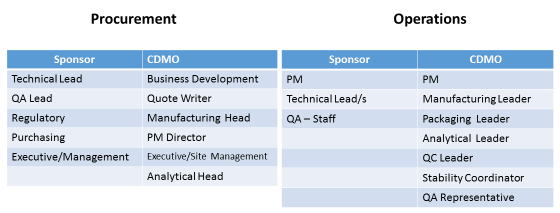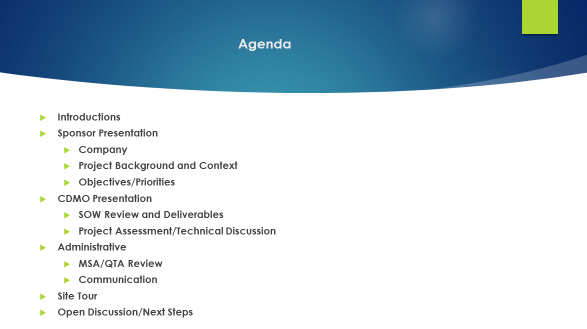CDMO Selection: How To Kick Off A Game-Winning Project
By Ray Sison
In my outsourcing experience, the transition from procurement to execution is always rushed. Often, critical activities like negotiating the master service agreement (MSA) take longer than expected, signatures are held up or purchase orders do not materialize. As a result, the project is behind before it even begins. Amidst tying up loose ends from the contracting phase and setting up the operational functions of the project, it is a tense yet exciting time for both the project sponsor and the CDMO. However, there is danger during the transition phase. In the rush and excitement, key connections vital to the success of the project can be missed. This will lead to miscommunication and misunderstanding — and eventually a strained relationship. Excitement can quickly give way to distress. Don't let this happen.
negotiating the master service agreement (MSA) take longer than expected, signatures are held up or purchase orders do not materialize. As a result, the project is behind before it even begins. Amidst tying up loose ends from the contracting phase and setting up the operational functions of the project, it is a tense yet exciting time for both the project sponsor and the CDMO. However, there is danger during the transition phase. In the rush and excitement, key connections vital to the success of the project can be missed. This will lead to miscommunication and misunderstanding — and eventually a strained relationship. Excitement can quickly give way to distress. Don't let this happen.
I have discussed the CDMO selection process in previous articles, ranging from request for proposal (RFP) development through negotiation and closing. This article explores the execution phase of outsourcing with a focus on the context and planning of the kickoff meeting. At this meeting, the handoff from the existing procurement team to the operations team will require close attention. Consider the following resources, inputs, and outputs:
- People: Who will be on the project teams? What are their respective roles and span of control?
- Information: What information will the teams need in order to create the deliverables in accordance with the project objectives?
- Process: What processes need to be utilized or established within each organization in order for them to progress the project?
- Materials: What materials will be needed and/or produced? How much and when?
- Technology: What technology, equipment, or capabilities will be required to execute the scope of work (SOW) and where does it reside?
- Documentation: What are the data, documentation, or other outputs related to the SOW and its objectives?
- Financial: What is the timing of spend, initiation costs, fees, penalties, or other financial triggers associated with the SOW?
Let’s examine each in further detail.
Include New Teams And Stakeholders
At kickoff, both the sponsor and CDMO will field new or modified teams and stakeholders. Note which procurement team members are exiting or will step back from active participation to become stakeholders. They maintain the project history and can recount important information about the selection process and original project objectives. Onboarding project managers (PMs) should be able to tap them as resources as needed.
Table 1: Project Team Transition for Technology Transfer and Scale-Up

Note that a PM is listed for both the sponsor and CDMO. It is highly advisable for the sponsor to assign its own PM as a single point of contact and coordinator of all sponsor-related activities associatedwith the project at the CDMO.
The takeaway from the example above is that contracting activities are typically exercised at a higher level and with a different set of personnel than the operations team — notably on the CDMO side. Resources that will be executing the SOW will operate at a granular level and may not be aware of overall project objectives, priorities, or strategies discussed and negotiated during procurement.
Information Must Flow In All Directions
While the kickoff is a formal transition, the transition will have already started at several key points prior to this. Compile any key learnings from previous interactions and use the meeting to communicate them to the operations team. At the CDMO, the team may not be able to put their daily activities into the context of the larger program or they may not have visibility into other critical workflows, e.g., clinical, regulatory, commercial, etc. The new teams will have varying and limited levels of familiarity with each other, their processes, and/or their capabilities. This is normal. In a well-planned kickoff meeting, take the opportunity to reintroduce the project. Strive to create a level playing field and a common knowledge base.
Key points of information exchange may include:
- First contact – The first information exchange begins the dialogue between the sponsor and the eventual CDMO. Any usable ideas or strategies from this point forward should be conveyed to the operations team.
- RFP development/SOW – Scope development represents a high level of information exchange, refinement, and detailed sequences, as well as groups of activities. This will directly inform the CDMO project plan and its integration into the global program plan.
- Site Visit Capabilities Assessment – Information exchange regarding facilities, equipment, process, and personnel will set expectations with the sponsor. In-depth technical discussions and preliminary project risk assessments may have been shared during the visit. Sponsor technical leads will likely have taken part in the site visit. These findings should be revisited and re-evaluated, especially if any of the assumptions have changed.
- Kickoff Prep – In the weeks prior to the kickoff, the PMs need to be assigned and must work together on the agenda, administrative items, information exchange, and procurement of long lead time items.
Agree On Process And Responsibilities
The MSA and quality technical agreement (QTA) are source documents for the responsibilities, representation, and warrants of each party. It is a best practice to have negotiators of these documents lead a high-level review of salient negotiated points affecting the execution of the MSA or defining responsibilities and specific activities from the QTA. Agreement by both parties is needed on how to operationalize provisions of the MSA and QTA, e.g., change orders, reserving manufacturing slots, ordering materials, deviations, dispute resolution, etc. I find that this topic fits well during a discussion of administrative items that are routinely covered during the kickoff meeting.
Early Procurement Of Materials
Because procurement of materials can often involve long lead times, it is an activity typically initiated weeks before the project kickoff. This requires assigning personnel, exchanging information, and establishing processes well ahead of the kickoff and will require some form of prepayment. In order to expedite project initiation, sponsors and CDMOs now routinely begin preliminary work prior to final execution of contracts. With agreement from both parties, some activities can be initiated on the basis of a letter of intent, purchase order, consultation agreement, limited SOW, etc. Be sure to understand the risks associated with initiating activities under a letter of intent, purchase order, or other arrangement short of a fully executed MSA and QTA.
Material flow outputs, e.g., engineering batches, clinical trial materials (CTM), registration batch manufacture timing and coordination will obviously be part of the kickoff agenda. The CDMO PM will be responsible for building realistic timelines based on requirements and expectations communicated to them during the kickoff meeting.
Identify All Necessary Technology
During the capabilities assessment visit, the CDMO will have identified equipment, manufacturing lines, personnel, and skillsets applicable to the SOW and project. If additional equipment, materials, or capabilities are needed, they need to be identified and included in the project activities. All resources that are heavily used will need to be reserved and coordinated. This includes personnel.
Set Expectations For Documentation
Well-written proposals will identify documents that are the deliverables for each phase of work. Consider these on par with material flow outputs and set expectations for quality, format, content, etc. When reviewing the SOW during the kickoff, create a checklist of deliverables and expected completion dates. If the operations team identifies additional deliverables or required adjustments that are not included in the SOW, these should be negotiated as part of the SOW.
Include Financial Projections
Typically, financial triggers and timing are not included in the kickoff agenda. However, both parties need to be clear on invoicing and payment processes, fees, penalties, pass-throughs, and other arrangements detailed in the MSA. Many sponsors benefit from receiving a timing of spend projection from the CDMO based on the timeline and anticipated milestones.
After taking a methodical approach to preparing for project initiation and the kickoff meeting, the sponsor should be proactive and generate an agenda to discuss with the CDMO setting expectations.
An example agenda for the meeting may look something like this:

Figure 1: Sample kickoff meeting agenda
Kickoff Meeting Best Practices
- Be present. Given the breadth of topics and importance of information exchange, do not forgo the opportunity to meet personally with the operations team and build rapport from the start.
- Be proactive. Develop an agenda and use it for preliminary talking points to set expectations for the kickoff meeting.
- Staff up. Recognize that personnel will be changing and that the newcomers will not have the benefit of accumulated knowledge gained in preceding months. Set a level playing field for all team members. Assign a PM prior to kickoff and well ahead of contract execution if timing is critical to coordinate activities with the CDMO.
- Build on what’s done. Use the MSA and QTA as a basis to assign responsibilities and to develop processes between companies. Review the SOW to highlight project deliverables and agree on strategy and rationale.
To summarize, considerable effort has been expended by both the sponsor and CDMO throughout the selection process. Transitioning to contract execution should be methodical, regardless of the rush and eagerness to move the project forward. In preparing for the kickoff meeting, a sponsor should take a methodical approach and work with the CDMO in a proactive way to script the kickoff meeting to effectively communicate the accumulated knowledge from the procurement teams to the operational teams.
About The Author:
 Ray Sison is VP of Pharmaceutical Outsourcing and Tech Transfer at xCell Strategic Consulting. He began consulting in 2011 after recognizing a need for expertise in pharmaceutical outsourcing among the discovery- and clinical-stage pharma companies he served as a business development representative for Patheon and MDS Pharma Services. Based on his experience, Sison provides insight to the CDMO’s business and operations, helping his clients negotiate and achieve better outcomes. Additionally, he has developed sound processes and templates to streamline CMO procurement to save time and cost. In this series of articles, as well as online webinars, he continues to share best practices and case studies, helping improve the outsourced business model. You can reach him at rsison@xcellstrategicconsulting.com or connect with him on LinkedIn.
Ray Sison is VP of Pharmaceutical Outsourcing and Tech Transfer at xCell Strategic Consulting. He began consulting in 2011 after recognizing a need for expertise in pharmaceutical outsourcing among the discovery- and clinical-stage pharma companies he served as a business development representative for Patheon and MDS Pharma Services. Based on his experience, Sison provides insight to the CDMO’s business and operations, helping his clients negotiate and achieve better outcomes. Additionally, he has developed sound processes and templates to streamline CMO procurement to save time and cost. In this series of articles, as well as online webinars, he continues to share best practices and case studies, helping improve the outsourced business model. You can reach him at rsison@xcellstrategicconsulting.com or connect with him on LinkedIn.
